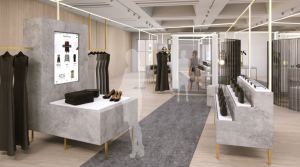Brick-and-mortar sales aren’t going anywhere. While the Covid-19 pandemic has certainly accelerated many ecommerce trends, physical stores still have a very important role to play, especially with Artificial Intelligence.
Pre-pandemic, 90% of goods purchased globally were done so in a physical store. So while the impact of the pandemic may have accelerated online shopping, it’s clear people still relish shopping in physical stores.
While people will return to physical stores it’s clear that things will not be the same again. In this article we discussed that post pandemic retail will see an increase in experiential retail. Bearing this in mind, one key element of delivering impactful experiences will be a retail’s ability to utilise technology.
Artificial Intelligence (AI) and Machine Learning (ML) have become key elements in the digitalization of in-store retail by personalizing the shopping experience and creating a more engaged business-to-consumer interaction.
For a retailer, AI creates an opportunity to bridge the gap between virtual websites and physical sales channels in real time. The retailer can build digitally connected retail locations and systems that facilitate unique customer experiences in order to sustain competitiveness over time.
In order to make the reinvention of in-store shopping worthwhile, “brick-and-mortar 2.0” simply won’t cut it. Brands need to reimagine the total in-store experience, and technology is key. In-store technologies and systems must be able to solve business processes and incorporate planning and strategy, rather than just implementing flashy, PR-driven technology.
It’s crucial the retailer effectively merges technology and function, which is why AI and ML are critical ingredients. Pop-up stores and shops are excellent vehicles for testing AI and Machine learning without investing huge amounts of money or having to make intrinsic changes to existing stores.
All about AI
Artificial intelligence, at its core, focuses on making machines intelligent or capable of solving problems as well as people can. Machine Learning is what AI uses to improve its processes in real time. Today, AI is able to make machines learn from experience, adjust to new inputs, and perform human-like tasks. It quickly combines large sets of data with fast, iterative processing and detailed algorithms, which allow the program to learn automatically from patterns in
But what does AI mean for the retail industry? No matter how big or small the retailer, every business can benefit from integrating AI into their daily functions. There are so many potential uses and benefits it’s almost impossible to list them all but we can bucket them into four main categories.
Acquisition
AI can help a physical store attract more customers. Understanding which products are sold more and the types of people they are purchased by can allow a business to more accurately advertise or offer relevant promotions to attract new customers. Using AI these campaigns can be implemented in real time and distributed to leads and prospective customers in your audience. What’s more, the insight you gather can help to tailor ongoing outbound marketing efforts, improving accuracy and performance.
Conversion and basket size
AI and ML can help increase the size of an individual’s basket using a self learning algorithm to make suggestions, recommendations or offer promotions where and when they would be the most impactful – at the point of sale. This could help point customers to particular shelves or objects based on what you know about that individual. AI could trigger messaging social media, email or on in-store displays to increase an individual’s basket size or tip them into converting.
Delivering experiences
By far the strongest application of AI in physical retail is in how it can be used to tailor the shopper experience. Retail brands need to focus on delivering impactful experiences in order to leverage the power of physical retail over its online equivalent.
The shopper experience can be optimised in a huge variety of ways. Providing customers with the services they want, delighting them with interactions and making their lives easier are the three main goals however. Imagine if a shopper enters a store and within minutes knows where their favourite product is, watches a cool video that appeals to them while they browse the rest of the store and are offered promotions and discounts on product related to the one they came in for?
Ai can generate predictive analytics to understand expectations and help you deliver what your customer wants as a priority. The key is to appeal to emotions. Much of the experience is about building customer and brand loyalty. By tailoring those experiences you are much more able to foster loyalty and advocacy.
Strategy
Data driven machine learning can benefit a business in a multitude of ways beyond the shop floor and the performance of an individual retail location. A more fluid approach to data and allowing AI to manage preferences and interpretations allows a business to make smarter decisions, stay ahead of its competitors and reduce waste.
Operational efficiency is another area that AI can benefit. Inventory management and merchandising can be improved significantly by AI. Understanding where stocks are and implementing data-driven logistics management systems can improve efficiency and reduce spending.
AI can be used to break down silos, increase productivity and improve outcomes. We’ve heard so much about how Big Data can help companies but AI is one of the key tool available that can truly activate the amounts of data most businesses manage. Activities and strategies throughout the business can and should be powered by big data unlocked by AI. This could be making a recommendation to inform demand forecasting and staying ahead of trends.
AI in today’s retail
From daily task management to gaining customer insights, AI is the foundation of technology in a retail setting. Utilizing artificial intelligence can free up time for business owners by completing daily tasks, which allows them to dedicate more time to advancing their overall business strategy. In addition, AI can even gather detailed customer patterns and preferences, which make for more informed business decisions in the long run.
When customer and sales data is processed through these algorithms, the AI model discovers actionable information about a business and its customers and inventory.
AI-equipped technology will soon be popping up everywhere in the retail industry, and many in-store experiences will be shaped by data crunching and AI. These will be the stores that thrive.

Ai in action: examples:
Farfetch
Fashion retailer Farfetch has come up with a solution to change the in-store experience for fashion retailers with its Store of the Future platform, which will “link online and offline channels, using data to enhance the retail experience,” says founder Jose Neves to Business of Fashion. Like e-commerce, the Store of the Future will allow businesses to collect customer data while they browse in-store. In the fitting room, smart mirror technology allows shoppers to request different sizes, colors, or items. The customer’s information and shopping habits is then stored in Farfetch’s database so that the company can later access information about that customer’s personal style, previous purchases and browsing history.
Not only does this create a better relationship between customer and sales associate, but it also allows the business to garner a wide collection of customer insights.
Business of Fashion Petah Marian, senior editor of retail intelligence at WGSN explains to Fast Company: “Understanding which products are being tried on and not bought, what’s being sized up or down, or being styled together, is the physical equivalent to knowing what was put into an online shopper’s cart and not bought.” Physical stores have lacked the ability to retrieve essential customer contact information. A retail location equipped with AI technology is a clever way to gain insight on shoppers’ habits and preferences.
Amazon
Amazon is a company we can’t not mention in a post about retail and artificial intelligence innovation. In many ways the entire Amazon business is powered by AI. Just think about the company’s robotics space and its huge Amazon Web Services (AWS) business before we even think about retail.
But, from a retail perspective, Amazon are the kings of recommendation and machine learning. When you buy a product online you are quickly provided with recommended items both on the web page you are on and later in your inbox. In fact, Amazon’s recommendation engine generates an estimated 35 percent of the company’s overall revenue.
How does this relate to physical retail you ask? Well, it’s no secret that Amazon has aspirations to expand into physical retail. In fact, it’s already made its first steps. So now, when someone from one of the Amazon 4 stars stores that same recommendation machine fires into action. What’s more Amazon’s purchase of Wholefoods in 2019, plus the launch of Amazon Go, means the web giant has more than 500 physical stores worldwide.
North face
The fashion retailer was an ‘early’ adopter of machine learning when it implemented its virtual assistant chat bot back in 2015. The partnership with IBM Watson meant conversion rates soared as the chat bot asked customers simple questions and then fed them recommendations. The clever part was how the chat bot learned from previous interactions because simple ‘if this then that’ logic could achieve the recommendations part. The chat bot used machine learning to tailor its responses based on the responses and previous conversions. While this was an almost exclusively online play the same methodology can and should be applied to in-store interactions and used as a bridge between the online and the offline. In-store interactions optimised in real time based on what has happened previously.
Macy’s
Just how the North Star example could be applied in a physical store is exemplified when we talk about Macy’s. Their Macy’s On Call app (again, built with IBM Watson) provides in-store guidance on what to buy and where. Customers use the app when they’re in a store and chat with the bot to get directions to specific items or see if what they are after is in stock. The app also flags if a customer is getting confused or frustrated and alerts a customer service representative.
Walmart
Walmart is planning on using robots to scan shelves. Yes, that’s right, actual robots. The robots will scan for missing items or pricing that needs updating. In a way they are digitising a previously physical activity. The robots will quickly learn where gaps are more likely to appear and focus their efforts where they are most required ensuring fully stocked shelves, accurate ricing and employees having more time to spend with customers.
Introducing experiential retail
With e-commerce disrupting the traditional brick-and-mortar sales channel, in many ways retail is transforming into an “experiential retail” model. Just as e-commerce sites are providing a revolutionized customer experience, in-store retailers must follow suit. A physical store is able to provide a much greater experience than can ever be delivered online and retailers need to double down on their strengths. Environments that attract and excite customers are supported by technological components, which are beneficial to both business and consumer. Moving forward, retailers will continue to employ cutting-edge technology, like artificial intelligence, in order to provide personalized offerings and engaging environments.
Check out these examples of experential retail in action.
Conclusions – how to implement AI
The focus of physical retail in future needs to be about delivering impactful experiences. In order to tailor those experiences with accuracy it is a necessity that we know about these individuals. The problem in many ways is that there is so much data available even in a physical environment that it can become overwhelming. Ai is a highly useful tool available to help businesses manage this data and create actionable and impactful output.
Artificial intelligence and machine learning can be an extremely powerful tool for the retail market. However, it’s important to understand that while it can drastically improve multiple capabilities it’s not a one trick fix. Often when we read about the latest innovation (this article included) it’s sold as a silver bullet that can solve all your problems. Then, when you take a step back and try to see how it could apply to your situation, or how you could implement it, it all seems utterly unattainable. The key is to pick one or two areas where you think it could have the most impact and the implement incremental changes. In many ways, AI is all about incremental changes so just adopt the same mentality. Make an impact in one small area and then move on to the next one. It is important not to get overwhelmed with all the options. Avoid paralysis analysis.
For some businesses, implementing AI technologies into existing physical stores or vast numbers of stores, could be a huge drain on time and money. In these instances it would be best to scope how you want AI to help you and run small tests, in individual locations. The greatest opportunity for these sorts of tests are short-term stores, or pop-up shops, which allow you to build something fantastic with less investment than a longer-term set up. Once you have run a pop-up store powered by AI you will know so much more about what it can do for you. Then you can pick and choose what you roll out elsewhere, learning from your failures and successes.








